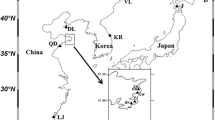Abstract
Muscari comosum L. (Liliaceae) has a chromosomal polymorphism for a pericentric inversion and a supernumerary chromosome segment probably due to an unequal interchange or insertional translocation. Both arrangements are widely distributed throughout the species range and the mean genetic distance among populations is D=0.131±0.075. There are no correlations between genetic distance and geographic distance or latitude. Only appreciable decreases in the frequencies of the inversion are detected in populations with ecologically marginal characteristics. There is a permanent and extended association between chromosomal inversion and an enzymatic locus (ADH). An excess of individuals heterozygous for the inversion was found and female productivity of heterozygotes is higher than that of corresponding homozygotes. A low rate of inversion heterozygosity in populations with ecologically marginal characteristics could be explained by natural selection. With respect to the adaptive role of the segment, although no homozygotes are found and may be selected against, heterozygotes could have heterotic effects.
Similar content being viewed by others
References
Anderson, W. W., Dobzhansky, Th., Pavlovsky, O., Powell, J. & Yardley, D., 1975. Genetics of natural populations XLII. Three decades of genetic changes in Drosophila subobscura. Evolution 29: 24–33.
Bentzer, B., 1972. Variation in the chromosome complement of Leopoldia comosa L. (Parl.) (Liliaceae). Bot. Notiser 125: 406–418.
Bentzer, B., 1973. Taxonomy, variation and evolution in representatives of Leopoldia Parl. (Liliaceae) in the Southern and Central Aegean. Bot. Notiser 126: 69–132.
Bentzer, B. & Ellmer, M., 1975. A case of stable chromosomal polymorphism in Leopoldia comosa (Liliaceae). Hereditas 81: 127–132.
Brown, A. H. D., 1979. Enzyme polymorphisms in plant populations. Theor. Pop. Biol. 15: 1–42.
Carson, H. L., 1958. The population genetics of Drosophila robusta. Adv. Genet. 9: 1–40.
Carson, H. L. & Heed, W. B., 1964. Structural homozygosity in marginal populations of neoartic and neotropical species of Drosophila in Florida. Proc. natn. Acad. Sci. U.S.A. 52: 427–430.
Cavalli-Sforza, L. L. & Bodmer, W. F., 1971. The genetics of human populations. Freeman, San Francisco.
Da Cunha, A. B., Dobzhansky, Th., Pavlovsky, O. & Spassky, B., 1959. Genetics of natural populations. XXVIII. Supplementary data on the chromosomal polymorphism in Drosophila willistoni in its relation to its environment. Evolution 13: 389–404.
Da Cunha, A. B., 1955. Chromosomal polymorphism in the Diptera. Adv. Genet. 7: 93–138.
Dobzhansky, Th., 1971. Evolutionary oscillations in Drosphila pseudo-obscura. In: Creed, R., ed., Ecological Genetics and Evolution. Blackwell, Oxford: pp. 109–133.
Fontdevila, A., Ruiz, A., Alonso, G. & Ocaña, J., 1981. Evolutionary history of Drosophila buzzatii. I. Natural chromosomal polymorphism in colonized populations of the old world. Evolution 35(1): 148–157.
Fontdevila, A., Ruiz, A., Ocaña, J. & Alonso, G., 1982. Evolutionary history of Drosophila buzzatii. How much has chromosomal polymorphism changed in colonization. Evolution 36(4): 843–851.
Garbari, F., 1966. Contributo allo studio citologico dei Muscari italiani. Caryologia 19: 419–428.
Garbari, F., 1969. Nuove osservazioni citologiche sui generi Muscari e Leopoldia. Giomale bot. Ital. 103: 1–9.
Garcia, L. J., 1981. Análisis de la variabilidad cromosómica que presenta en Sierra Nevada el subgénero Leopoldia del género Muscari (Liliaceae). Tesina Univ. de Granada.
Harris, H., 1980. The principles of human biochemical genetics. 3rd. ed., Elsevier North Holland Biomed. Press, Amsterdam.
Lewontin, R. C., 1974. The genetic basis of evolutionary change. Columbia University Press, New York.
Lewontin, R. C. & White, M. J. D., 1986. Interaction between inversion polymorphism of two chromosome pairs in the grasshopper Moraba scurra. Evolution 14: 116–129.
Prevosti, A., 1974. La distancia genética entre poblaciones. Miscellánea Alcobé, Public. Univers. Barcelona: pp. 109–118.
Prevosti, A., 1978. Polimorfismo cromosómico y evolución. Investigación y Ciencia, Nov. 1978: 90–103.
Ruiz Rejón, C., 1985. Análisis de la variabilidad genética de Muscari comosum L. (Liliaceae). Ph. Thesis Univ. Granada.
Ruiz Rejón, C., Lozano, R. & Ruiz Rejón, N., 1987a. Genetic variability in Muscari comosum L. (Liliaceae). II. Characterization and effects on chiasma formation of the polymorphic variants of chromosome 2. Genome 29: 19–26.
Ruiz Rejón, C., Lozano, R. & Ruiz Rejón, N., 1987b. Genetic variability in Muscari comosum (Liliaceae). III. Enzyme polymorphism in European and Canarian populations. An. Est. exp. Aula Dei, in press.
Ruiz Rejón, M. & Oliver, J. L., 1981. Genetic variability in Muscari comosum (Liliaceae). I. A comparative analysis of chromosome polymorphism in Spanish and Aegean populations. Heredity 47(3): 403–407.
Ruiz Rejón, M., Pascual, L., Ruiz Rejón, C., Valdes, B. & Oliver, J. L., 1985. A new species of Muscari subgenus Leopoldia from the Iberian Peninsula. Biochem. Syst. Ecol. 13(3): 239–250.
Selander, R. K., Smith, M. H., Yang, S. Y., Johnson, W. E. & Gentry, J. B., 1971. Biochemical polymorphism and systematics in the genus Peromyscus. I. Variation in the old-field mouse (Peromyscus polionotus). Univ. Texas Publ. 7103.
Schroeter, G. L., 1968. Pericentric inversion polymorphism in Trimerotropis helferi (Orthoptera: Acrididae) and its effects on chiasma frequency. Ph. Thesis, University of California.
Singh, B. N., 1983. Cosmopolitan inversions in Drosophila ananassae. Caryologia 36(4): 333–343.
Sokal, R. R. & Rohlf, F. J., 1969. Biometry, W. H. Freeman, San Francisco.
Sperlich, D., 1964. Chromosomale Strukturanalyse und Fertilitätsprüfung an einer marginalen Population von D. subobscura. Z. VererbL. 93: 73–81.
Swofford, D. L. & Selander, R. B., 1981. Biosys-1: a Fortran program for the comprehensive analysis of electrophoretic data in population genetics and systematics. J. Hered. 72: 281–283.
Weissman, D. B., 1976. Geographical variability in the pericentric inversion system of the grasshopper Trimerotropis pseudofasciata. Chromosoma 55: 325–347.
Wright, S., 1951. The genetical structure of populations. Ann. Eugen. 15: 323–354.
Wright, S., 1978. Evolution and the genetics of populations. Vol. 4. Variability within and among natural populations. Univ. of Chicago Press, Chicago.
Wright, S. & Dobzhansky, Th., 1946. Genetics of natural populations. XII. Experimental reproduction of some of the changes caused by natural selection in certain populations of Drosophila pseudoobscura. Genetics 31: 125–156.
Author information
Authors and Affiliations
Rights and permissions
About this article
Cite this article
Ruiz Rejón, C., Lozano, R. & Ruiz Rejón, M. Genetic variability in Muscari comosum L. (Liliaceae) IV Geographical distribution and adaptive role of the polymorphic variants of chromosome 2. Genetica 81, 133–142 (1990). https://doi.org/10.1007/BF00226452
Received:
Accepted:
Issue Date:
DOI: https://doi.org/10.1007/BF00226452




